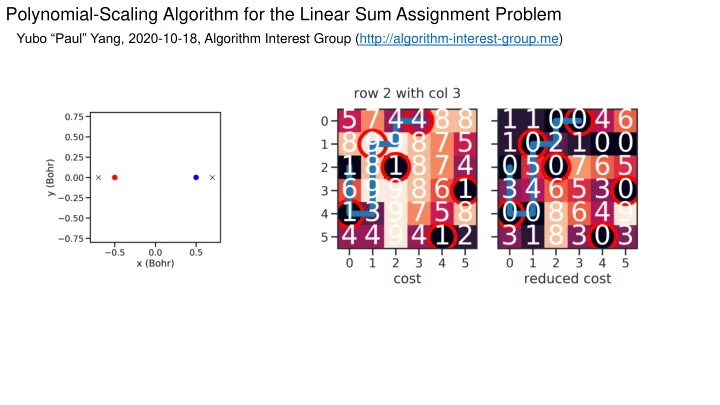

Polynomial-Scaling Algorithm for the Linear Sum Assignment Problem Yubo “Paul” Yang, 2020 -10-18, Algorithm Interest Group (http://algorithm-interest-group.me)
What is the (balanced) linear sum assignment problem (LSAP)? Goal find minimum-cost assignment of n “agents” to n “tasks” . Problem defined by a cost matrix. 𝑑 𝑗𝑘 is the cost to assign agent 𝑗 to task 𝑘 . cost 𝑨 assignment 𝝔 Mathematically a linear programming (LP) problem: Example: 𝑜 𝑜 𝑦 𝑗𝑘 = 𝜀 𝑗𝑘 𝑑 𝑗𝑘 𝑦 𝑗𝑘 Minimize 𝑗=1 𝑘=1 𝑜 𝑦 𝑗𝑘 = 1 with constraints 𝑗=1 𝑜 𝑦 𝑗𝑘 = 1 𝑘=1 𝑦 𝑗𝑘 ≥ 0, ∀𝑗, 𝑘
What is the (balanced) linear sum assignment problem (LSAP)? Example 2x2 Example 3x3 assignment 𝝔 is a permutation of length n ⇒ 𝑜! possibilities!
Why solve LSAP? Many practical (real-world!) applications Choose 4/n swimmers for relay team (back, breast, butterfly, free style) [1] Vehicle routing problems (eg. Taxi, flights) [2] Reconstruct mass distribution in the early universe [3] Shoot down Soviet nukes [4] Quantum exchange [5] [1] R.E. Machol , “An application of the assignment problem,” Oper. Res. 18 , 745 (1970) [2] M. Fischetti, A. Lodi, S. Martello, and P. Toth , “A polyhedral approach to simplified crew scheduling and vehicle scheduling problems,” Management Sci. 47 , 833 (2001). [3] U. Frisch and A. Sobolevskii , “Application of optimal transport theory to reconstruction of the early universe,” J. Math. Sci. 133 , 1539 (2006). [4] B.L. Schwartz, “A computational analysis of the auction algorithm,” Euro. J. Oper. Res. 74 , 161 (1994). [5] D.M. Ceperley, G. Jacucci , “Calculation of Exchange Frequencies in bcc 3He with the Path - Integral Monte Carlo Method,” Phys. Rev. Lett. 58, 1648 (1987).
How to solve LSAP? Short answer: read a book [1] I will walk through the internals of the “Hungarian algorithm” Dénes K ő ni g Jen ő Egerváry [1] Rainer Burkard, Mauro Dell’Amico , Silvano Martello, “Assignment Problems : Revised Reprint,” SIAM (2009). [2] T. Bonniger, G. Katzakidis, R.E. Burkard, U. Derigs, “Solution Methods with FORTRAN - Programs”, Springer -Verlag Berlin (1980).
ҧ ҧ Primal-dual formulation of the LSAP Cost Reduced set dual variable ֞ Matrix Cost set primal constraint Matrix 𝒗 = (2, 1, 1) 𝒘 = (0, 0, 0) 𝑑 𝑗𝑘 𝑑 𝑗𝑘 admissibility transform 𝑑 𝑗𝑘 = 𝑑 𝑗𝑘 − 𝑣 𝑗 − 𝑤 𝑘 Primal problem Dual problem 𝑑 is Take home: each 0 in ҧ 𝑜 𝑜 𝑜 𝑜 admissible in an optimal primal 𝑑 𝑗𝑘 𝑦 𝑗𝑘 𝑣 𝑗 + 𝑤 𝑘 Minimize Maximize assignment. 𝑗=1 𝑘=1 𝑗=1 𝑘=1 𝑜 𝑑 𝑗𝑘 − 𝑣 𝑗 − 𝑤 𝑘 ≥ 0, ∀𝑗, 𝑘 with constraints 𝑦 𝑗𝑘 = 1 with constraints 𝑘=1 𝑜 𝑦 𝑗𝑘 = 1 𝑗=1
The Hungarian algorithm : simultaneous primal and dual solutions Big idea: By duality theorem, an optimal solution to both primal and dual problems is THE optimal solution. Algorithm: 1. Initialize ultra optimal dual variables. Only a partial primal assignment is admissible . 2. Search admissible solutions for the primal assignment with largest cardinality. 3. If all tasks assigned, then done. 4. Otherwise relax constraints, i.e. decrease dual cost function by minimum reduced cost .
Timings Three implementations: • Yang (Python) 𝑜 3 • Ceperley (FORTRAN) • Scipy 𝑜 2+𝜗 Which one is which? • Method 1 = Ceperley (FORTRAN) • Method 2 = SciPy • Method 3 = Yang (Python)
Implementation Breakdown (Python) [1] Rainer Burkard, Mauro Dell’Amico , Silvano Martello, “Assignment Problems: Revised Reprint,” SIAM (2009).
Implementation Breakdown (FORTRAN) Enlarge primal assignment Update dual variables [2] T. Bonniger, G. Katzakidis , R.E. Burkard, U. Derigs, “Solution Methods with FORTRAN - Programs”, Springer -Verlag Berlin (1980).
Your Application! Assign project teams? Dating app? : optimal assignment of stable marriages Your idea goes here!
Conclusion: The Hungarian alg. is a primal-dual poly.-time solution to the LSAP 𝑜 3 𝑜 2+𝜗
Recommend
More recommend